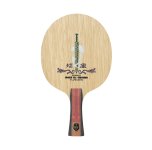Not sure if the information being the same means they are fake or not. That may be the case. Or DHS may just put the same number for those three categories on all HL5 blades based on only measuring one blade. Especially if those are the "commercial" version of the HL5 and not a W997 or W968. But, maybe they do actually take those measurements on each separate blade.
Regardless of whether the blades are real and DHS took a shortcut or the blades are not real, I would say this:
I would not decide whether to buy or not to buy any blade based on those numbers. That would probably be an even worse idea than trying to rely on the type of blade review that gives simple information like: "this is the best blade ever! I love it." From an unknown source.
The true, best way to tell if a blade or a setup would be good for you would be to try it. Of course that is not always possible. But when you play at a club with other tournament level players, there are always many people with many different rackets. If you are looking for a new setup and wanting something that will be really good for you, it is worth asking anyone you hit with if you can take a 2 min knock with their racket to see what it plays like. If you do that, every so often, someone will hand you a racket that you instantly feel is really nice, maybe even special; once in a while you will hit with something that clicks and feels magical for you. Often one of those, may be a good racket for you to use yourself. And it is important to know, if you try 20 rackets from players who understand equipment and are using something that is really good for them, of those 20 rackets, it could be that 10-20 of them make you think: "this is the one I want."
But all you need is 1. [emoji2] So it is nice to know that there are many good rackets and setups that would be good FOR YOU, even though there are many many rackets that are fancy, expensive and probably not right FOR YOU!--even if they are good for someone else.
Sent from the Oracle of Delphi by the Pythia













